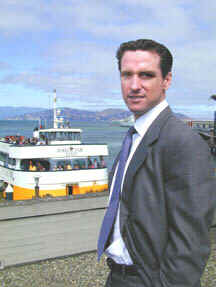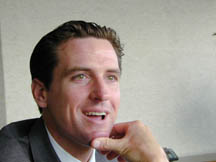 |
| "The
point is that our best economic calculus is to make the
environmental investments upfront and not pay the price in the
long run." |
Do you favor higher bridge tolls as a way
of discouraging automobile use and funding public transportation?
I think it is critical. The fact is we
canít encourage, as we do now, 80% of our commuters to use the
automobile and have just 4/10th of one percent using ferry service and
expect to survive in the long run with the projected increases in the
population. Iíve always been for peak pricing. Iíve never
necessarily been with those who feel that peak pricing is particularly
unfair and I have no problem with increased tolls. Itís the carrot and
the stick. You have to concurrently provide options for people to get
out of their automobiles. But we have to be more aggressive. And yes, we
have to be punitive of those who want the privilege of being a single
occupant driving along commute corridors where there is a viable public
transportation alternative.
| |
| "We
have to be punitive of those who want the privilege of being a
single occupant driving along commute corridors where there is a
viable public transportation alternative." |
Getting in and out of San Francisco is a
deeply dispiriting experience. Before the bridges were built, that wasnít
the case. For example, youíre a restaurateur, you may be surprised to
know that some of restaurants were on the ferry boats. Did you know
that?
I did not know that. Thatís
fascinating.
Was building the Bay Bridge in the first
place a mistake? Serving rather to divide the Bay Area instead of
uniting it?
Thatís a good question. I will have to
give that more thought. My first instinct, of course, is no, it wasnít
a mistake. I really have to consider that in a larger sense. I donít
necessarily see it as dividing the region. I think in many respects it
unites it. But clearly what the bridge has done to me is analogous of
what great economic times have done to our decision making process
generally. It allows you not to make the tough decisions. Building a
freeway allows you the privilege of not having to make the tougher long
term decisions because you have in essence reduced the propensity for
people complaining because it is easier for people to get from point A
to point B for a period of time and then eventually things clog and you
are back having to make those tough choices. But you are reacting as
opposed to being proactive and the Bay Bridge I think is a good example
of that. For many, many years it made this region I think move more
efficiently and I think has been very advantageous, but for years and
years weíve been neglectful of alternatives.
Are environmentally friendly ferries
possible?
Yes. There are examples all over the
world. Itís a question of are they feasible in economic terms and I
think that is the balance. Youíve got to provide an alternative that
is efficient and meets the needs of the highly engaged economic engine
which is the Bay Area region. Itís got to be a viable alternative to
the automobile. I am convinced that there are those models that will
provide us both environmental sustainability and the efficiencies of
technologywe need.
Do you feel caught between
environmentalists calling for expensive plans to improve the Bay
environment and industry figures who are unhappy about those pressures?
Hereís my bias: the upfront costs of
being environmentally considerate pale in comparison to the neglect of
not considering the environmental consequences. I think it is an
outrage, not a shame, an outrage that in San Francisco we have
warnings against people eating more than four fish a month. The
environmental impacts of dioxins, the environmental impacts of our
neglect in terms of economic impacts, are extraordinary. But they are
not felt immediately. So from our perspective the incremental costs
upfront of being environmentally considerate are wildly inexpensive in
comparative terms to the neglect of the environment in the long run. So
those upfront costs are well served. They are great investments; they
are great economic investments at the same time.
| |
| "Hereís
my bias: the upfront costs of being environmentally considerate
pale in comparison to the neglect of not considering the
environmental consequences." |
An analogy is the treatment and
prevention in drugs. You can sit back and be punitive with this failed
drug war and spend your time on that or you can spend your time on
treatment and prevention and reap huge rewards, but the upfront costs
people are constantly pushing people off because they donít want to
open up another treatment facility. The point is that our best economic
calculus is to make the environmental investments upfront and not pay
the price in the long run.
Are you satisfied with what the WTA is
doing to address the issue of ferries and the environment?
Yes, we are too new to criticize,
frankly. I mean we are just getting up and running. Consultants are just
being hired. Consultant reports are not back yet. We will be looking
forward to debating these issues in upcoming months. Weíll see. Itís
too early to tell. But I think that youíve got to keep an eye on us.
The environmental community needs to keep an eye on us and now is the
time to do it. Hold our feet to the fire.
 |
| Newsom
thinks the new Ferry Building and Terminal, set to open in
stages over the coming 18 months, may well challenge the
dominance of Fishermenís Wharf as a tourist center. ", I
think it promises to be more than just a tourist destination. I
think it is going to bring a lot of residents of the City back
to their waterfront and I hope it does provoke a new
consideration of what a waterfront can be about". |
The Ferry Building is being rebuilt and a
new Ferry Terminal is opening soon. Do you think that the foot of Market
might become a tourist attraction once all this opens and might this
challenge the dominance of Fishermanís Wharf as a tourist attraction?
I hope so and looking at the plans for
what they are doing at the Ferry Building and the restaurants, the
cafes, the other retail outlets, I think it promises to be more than
just a tourist destination. I think it is going to bring a lot of
residents of the City back to their waterfront and I hope it does
provoke a new consideration of what a waterfront can be about. I mean if
this vision is materialized I think it is a great model for the rest of
our waterfront and a waterfront that continues to evolve and expand and
make its way into the Bayview-Hunters Point area. So itís an exciting
prospect of things to come.
Is more waterfront development along the
lines of the renovated Ferry Building, Pac Bell Park, multiple plans for
arenas, is this simply inevitable?
It is inevitable. No one wants rotting,
decaying piers. In the long run, some may, but there can be a balance of
open space, a balance of recreation, a balance of industry and maritime
use. Again, I want to stand up for a working waterfront as well as
tourism. And, I think, in many respects we are seeing some good evidence
that supports that from our Port. At the same time, we are seeing some
projects that are not necessarily getting to the fore on their merits,
but on political considerations and we are seeing the dominance of money
influencing the process. There is no surprise there, but it seems to be
disproportionate in our waterfront, and I think it raises a lot of
questions and flags for those that are concerned about its future and
viability, including my own.
Many people are surprised to learn that
San Francisco doesnít have legal title to the Port of San Francisco.
It is owned by the state and the laws governing San Francisco
stewardship of the Port of San Francisco require that the port be
limited to maritime purposes. Is this obsolete?
No. I mean, itís amazing if you read
the Burton doctrine that governs our waterfront here and then you see
the actions at times of the Port. They are in stark contrast. So there
is a lot of interpretation that is afforded our Port Commission and Port
Staff. Unfortunately, at times that interpretation I think takes
liberties. But I think that in the margins a lot of good things are
happening down here. San Francisco does need to influence the process
because without that influence, I dare suggest that the Port may be
venturing in areas that divide San Franciscans from their waterfront.
There is evidence, like with our referendum on the Pier 45 development
proposal that suggests San Franciscans can have a huge and profound
effect. The Board of Supervisors still deals with economic
considerations, leases must come in front of the Board, and policy
decisions are left with the staff, and of course the Port Commission.
But in terms of the economic considerations, the City and County of San
Francisco does have tremendous amount of influence. We will be watching
closely, for example, the Mills development and all the controversy
around Chelsea and Mills.